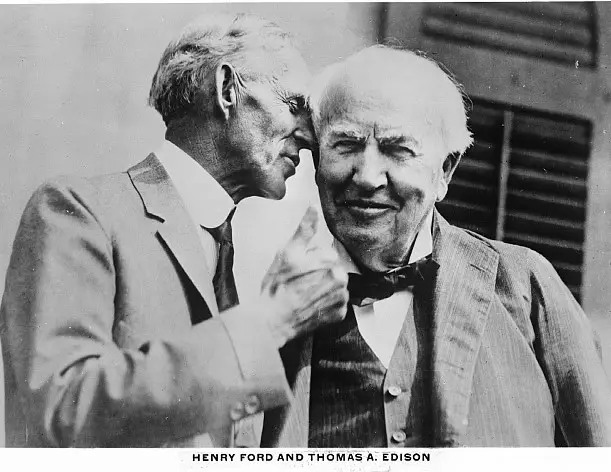A Visionary in the Driver’s Seat
Henry Ford, born in 1863 in Greenfield Township, Michigan, is often hailed as one of the most influential figures of the 20th century. The founder of the Ford Motor Company, Ford did not just create automobiles—he transformed the way they were made, revolutionizing industrial production with the introduction of the assembly line. This innovation made cars affordable for the average person, democratizing transportation and changing the very fabric of society. But Ford’s legacy is more than just his machines; it is a story of innovation, relentless drive, and the complex interplay between a brilliant mind and controversial views. Let’s explore how Henry Ford forever changed the course of history.
Early Life: A Tinkerer with Big Ambitions
Born to a family of farmers, Henry Ford showed an early interest in machines and mechanics. He spent his boyhood fascinated by anything mechanical, often taking apart and reassembling pocket watches and farm equipment. However, farming did not appeal to Ford. After completing school, he left home at age 16 to work as an apprentice machinist in Detroit, where his technical skills flourished.
Ford returned to his family’s farm in 1882, but his passion for machines continued to grow. His first encounter with a gasoline-powered engine in the 1890s ignited a lifelong obsession with creating a machine that would change transportation forever. Ford’s dream was not just to build a car, but to make it accessible to ordinary people, not just the wealthy. His desire to transform society through affordable automobiles became his driving purpose.
The Model T: The Car That Changed Everything
In 1908, Ford introduced the Model T, the vehicle that would define his legacy. At the time, cars were a luxury, hand-assembled and too expensive for most Americans. Ford, however, envisioned a car that was reliable, easy to repair, and—most importantly—affordable. The Model T, affectionately known as the “Tin Lizzie,” became an instant success. Priced at $850 initially (about $25,000 today), the Model T was revolutionary not just because of its design, but because of how it was produced.
Ford’s greatest innovation wasn’t the car itself, but the method he developed to build it. In 1913, Ford introduced the moving assembly line at his Highland Park plant, a breakthrough that allowed cars to be produced more efficiently than ever before. Instead of skilled workers crafting a car from start to finish, the assembly line allowed each worker to focus on one specific task, speeding up production and driving costs down. By 1925, the Model T was selling for as low as $260, making it affordable for millions of Americans.
Mass Production: The Birth of Modern Industry

Ford’s assembly line wasn’t just a technical innovation—it was a societal shift. His approach to mass production forever altered the manufacturing landscape, influencing industries far beyond the automobile. The assembly line drastically increased productivity, cutting the time to build a car from 12 hours to just 90 minutes. This efficiency not only made cars affordable but also allowed for higher wages. In 1914, Ford famously introduced the five-dollar workday, more than doubling the average wage for factory workers at the time. While this bold move shocked many business leaders, it had a profound impact on the economy, allowing workers to afford the very products they were building, thus fueling consumer demand.
Ford’s influence extended beyond manufacturing; he helped shape modern labor practices, contributing to the rise of the middle class. His vision wasn’t just about profits but about creating a cycle where improved wages fueled greater consumer spending, which in turn stimulated economic growth.
Controversies: Genius and Flawed Visionary
While Henry Ford’s contributions to industry are undeniable, his personal views and actions also garnered significant controversy. Ford was an outspoken pacifist during World War I, launching a failed peace mission to Europe in 1915. His opposition to war was admirable, but his anti-Semitic views and the publication of offensive articles in his newspaper, The Dearborn Independent, cast a dark shadow over his legacy. His writings, which were later compiled into a book titled The International Jew, promoted harmful and dangerous conspiracy theories, and his anti-Semitism was widely condemned.
Though Ford later publicly apologized and closed the paper, the damage was done. His personal beliefs continue to complicate how we view his accomplishments, reminding us that even great innovators can be deeply flawed individuals.
The Impact on Society: Cars for the People
Despite the controversies, Ford’s influence on society remains profound. By the time the last Model T rolled off the assembly line in 1927, Ford had sold over 15 million units. The automobile transformed life in America and around the world, making travel faster and more accessible. Roads, cities, and suburbs expanded as people no longer needed to live near their workplaces. Entire industries, such as oil, rubber, and steel, boomed as a result of Ford’s mass production techniques.
Ford’s innovations set the stage for the rise of the American middle class and ushered in a new era of consumer culture. His vision of affordable automobiles led to the democratization of mobility, giving ordinary people the freedom to travel, work, and live farther from city centers.
The Later Years: Legacy of a Revolutionary
Henry Ford remained a dominant force in the automotive industry well into his later years. Even after stepping down as president of Ford Motor Company in 1919 (though he retained substantial control), Ford continued to influence both his company and the industry at large. During World War II, Ford shifted his production lines to help the war effort, building bombers and military vehicles for the Allies.
Although Ford’s health began to decline in the 1940s, his influence endured. He passed away in 1947 at the age of 83, leaving behind a complex legacy of innovation, industrial revolution, and personal contradictions. His contributions to manufacturing and the American economy are felt to this day, as modern assembly lines and automation trace their roots to his early innovations.



